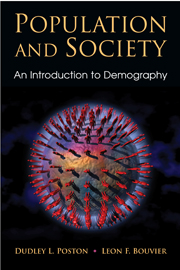Book contents
- Frontmatter
- Contents
- Preface
- Introduction
- 1 “We Are All Population Actors”: An Introduction to Demography
- 2 The Sources of Demographic Information
- 3 Fertility
- 4 Contraception and Birth Control
- 5 Mortality
- 6 Internal Migration
- 7 International Migration
- 8 Age and Sex Composition
- 9 World Population Change over Time
- 10 Population Change in the United States
- 11 Population Distribution
- 12 Cultural Adaptation and Growth
- 13 Population Policy
- 14 The Future of Planet Earth
- Glossary
- References
- Author Index
- Subject Index
11 - Population Distribution
- Frontmatter
- Contents
- Preface
- Introduction
- 1 “We Are All Population Actors”: An Introduction to Demography
- 2 The Sources of Demographic Information
- 3 Fertility
- 4 Contraception and Birth Control
- 5 Mortality
- 6 Internal Migration
- 7 International Migration
- 8 Age and Sex Composition
- 9 World Population Change over Time
- 10 Population Change in the United States
- 11 Population Distribution
- 12 Cultural Adaptation and Growth
- 13 Population Policy
- 14 The Future of Planet Earth
- Glossary
- References
- Author Index
- Subject Index
Summary
INTRODUCTION
Whether looking at the planet Earth, or at Africa or the United States, it is clear that the population is far from being equally distributed around the world. The spatial demographer Mark Fossett has written that “structured patterns in spatial distribution are evident from the highest levels of macrospatial scale…to ‘fine-grained’ patterns in metropolitan areas…and nonmetropolitan hinterlands” (2005: 479).
Most know that China's population numbers more than 1.3 billion, and the population of the United States is just over 300 million. However, many may not be aware that China and the United States are very close in geographic size; China has 9.6 million square kilometers of surface area compared to the United States with 9.8 million square kilometers. But the populations in both countries are not distributed randomly. Most of the people in both countries live in the eastern regions. Figures 11.1 and 11.2 are nighttime satellite maps of the United States and China and illustrate well the uneven distribution of the population in the two countries.
In some countries, people are more likely to be rural than urban dwellers. Generally, however, there is an urbanization movement throughout the world: “Without question, the dominant feature of spatial distribution in the United States and other developed countries is the concentration of population in densely settled urban areas” (Fossett, 2005: 479). For that matter, the way in which cities have evolved is a quite interesting phenomenon.
- Type
- Chapter
- Information
- Population and SocietyAn Introduction to Demography, pp. 301 - 323Publisher: Cambridge University PressPrint publication year: 2010

